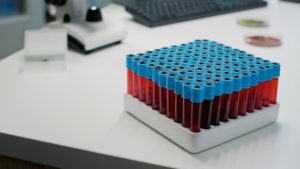Female Infertility Assessment
Ovarian Reserve Assessment
Nowadays, the age of trying to get pregnant has started to be postponed due to the increase in women’s education and career goals. For this reason, many women today present with infertility due to decreased ovarian reserve.
What does a decreased ovarian reserve mean?
Low ovarian reserve means that the number of follicles (fertility cells) in a woman’s ovaries is reduced. The most important factors among the causes of low ovarian reserve is the age of a woman. As age increases, especially after the age of 35, the number and quality of follicles decrease. Regular menstruation every month does not indicate a good ovarian reserve. Women with low ovarian reserve may also have regular menstruation for a long period of time.
What are the causes of a low ovarian reserve?
The most important factor of decreased ovarian reserve is advanced maternal age. Other causes are as follows:
- Family history of early menopause
- Previous ovarian operations
- Radiotherapy and chemotherapy (cancer treatment)
- Smoking and alcohol consumption
- Endometriosis and chocolate cysts
- Being overweight
Which tests are used to assess ovarian reserve?
On the 2nd-3rd day of menstruation, antral follicles (fertility cells) in the ovaries are counted by vaginal ultrasonography. If this number is low, it means that the ovarian reserve is reduced. In addition, AMH (Anti-Müllerian Hormone) and FSH (Follicle Stimulating Hormone) levels also provide information about ovarian reserve.
What is the AMH test?
The AMH test is a blood test that provides information about ovarian reserve. It is a test that can be performed independently of the menstrual day, ‘low value’ suggests decreased ovarian reserve and ‘high value’ suggests Polycystic Ovary Syndrome.
What is the FSH test?
 FSH is a hormone secreted from the brain that stimulates the ovaries. It is analysed in the blood on the 2nd or 3rd day of menstruation. High FSH indicates a low ovarian reserve. Normal values do not necessarily mean that the amount of eggs is good. Ovarian reserve is most accurately determined by evaluating the number of antral follicles, AMH and FSH together.
FSH is a hormone secreted from the brain that stimulates the ovaries. It is analysed in the blood on the 2nd or 3rd day of menstruation. High FSH indicates a low ovarian reserve. Normal values do not necessarily mean that the amount of eggs is good. Ovarian reserve is most accurately determined by evaluating the number of antral follicles, AMH and FSH together.
Other Hormone Tests
In women, hormones of some glands other than the ovaries also affect fertility. Thyroid hormone disorders can be assessed by TSH (Thyroid Stimulating Hormone) and free T4 (Thyroxine) levels. In addition, the PRL hormone (Prolactin) also affects fertility. Elevated PRL can be a cause of infertility.
Hysterosalpingography (HSG)
Hysterosalpingography is an imaging method that is used 3-4 days after the end of menstruation to evaluate the uterine cavity and the patency of the tubes with a radio-opaque substance given into the uterus. With this imaging, congenital anomalies in the uterus, subsequent space-occupying pathologies (such as fibroids, polyps, adhesions) are evaluated. In addition, information about the patency of the fallopian tubes is obtained.
Laparoscopy
Laparoscopy is the process of inserting a camera system illuminated by a light source into the abdominal cavity, observing the intra-abdominal organs and performing simultaneous operations when necessary. Laparoscopic surgery in infertility is frequently used for opening intra-abdominal adhesions, removal of tubes, closure of tubes, removal of ovarian cysts and fibroids.
Male Infertility Assessment
Semen Analysis
The basic investigation for male infertility is the spermiogram. In this test, a semen sample given after 3-4 days of sexual abstinence is analysed. The number of sperms in 1 ml of semen sample, sperm motility rate, the shape of the sperms, and other parameters are evaluated.
The semen sample must be given by means of masturbation.In men who cannot give the sample under this condition which may be due to various reasons, sperm sample can be obtained from the testicular ducts with an injector. In addition, in cases where semen ejaculates into the urinary bladder instead of coming out (retrograde ejaculation), the sperms can be collected from the urinary bladder to be used in IVF treatment.
Genetic Investigation
 The frequency of genetic disorders in infertile men is 5.8%. Especially, the frequency of genetic abnormalities increases as the sperm count decreases. Therefore, genetic evaluation is necessary in patients with sperm count below 3 million/ml or in patients with no sperm in semen (azoospermia).
The frequency of genetic disorders in infertile men is 5.8%. Especially, the frequency of genetic abnormalities increases as the sperm count decreases. Therefore, genetic evaluation is necessary in patients with sperm count below 3 million/ml or in patients with no sperm in semen (azoospermia).
Hormone Tests
In cases where the sperm count falls below 10 million/ml, hormonal tests are necessary. For this purpose, FSH (Follicle Stimulating Hormone), total testosterone, LH (Luteinizing Hormone) , PRL (Prolactin), estrogen and thyroid hormone examinations are performed.
Ultrasound Examination
If necessary, ultrasound examination of the scrotum and testicles is requested after the urological examination.


Leave a Reply
You must be logged in to post a comment.